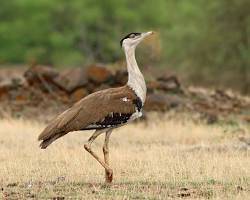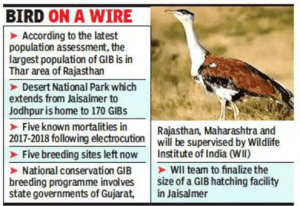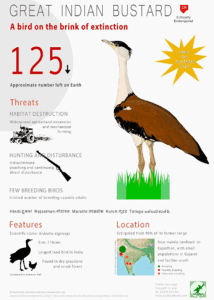TAG: GS- 3: ENVIRONMENT AND ECOLOGY
THE CONTEXT:
The Supreme Court decision to form an expert panel to address the critical issue of balancing the conservation of the endangered Great Indian Bustard bird population and the deadline for the panel to submit its report to the Supreme Court by July 31 underscores the urgency of the matter while providing a clear timeline for action.
EXPLANATION:
MORE ABOUT NEWS:
- The Supreme Court’s decision to form an expert panel to address the critical issue of balancing the conservation of the endangered Great Indian Bustard bird population with the promotion of renewable energy sources is a significant step towards sustainable development and environmental protection.
- The panel’s mandate to assess the scope, extent, and feasibility of underground and overhead electric lines in priority areas for the Bustard population in Rajasthan and Gujarat underscores the importance of evidence-based decision-making. By considering factors such as habitat suitability, population dynamics, and technological feasibility, the committee can propose targeted interventions that minimize the risk of bird collisions while supporting the expansion of renewable energy infrastructure.
- Furthermore, the committee’s commitment to exploring alternative approaches and recommending additional measures to identify priority areas demonstrates a proactive stance towards finding holistic solutions that address the needs of both wildlife and human communities.
ABOUT GREAT INDIAN BUSTARD:
- It is known as the Indian Bustard, is a majestically large bird found on the Indian subcontinent.
- It is one of the heaviest flying birds in the world, with males reaching up to 1.2 meters (4 feet) tall and weighing in at 15 kg (33 pounds).
- These birds are easily distinguished by their black crown contrasting with their pale neck and head, and their brownish body with black, brown, and grey markings on their wings.
- The Great Indian Bustard is classified as critically endangered. Once common on the dry plains of India, there are only an estimated 150 individuals left in the wild.
- There are two main threats to their existence: habitat loss and hunting.
- Their natural habitat consists of large expanses of dry grasslands and scrub. However, this habitat is being lost due to agricultural development, overgrazing, and the planting of trees. Great Indian Bustards are hunted for their meat and feathers.

The distribution of the Great Indian Bustard:
- The great Indian bustard was distributed throughout Western India, spanning 11 states, as well as parts of Pakistan. Its stronghold was once the Thar desert in the north-west and the Deccan plateau of the peninsula. Today, its population is confined mostly to Rajasthan and Gujarat.



